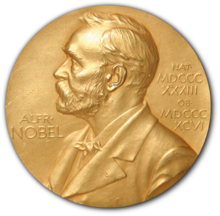 Today (October 9, 2013), The Royal Swedish Academy of Sciences awarded the 2013 Nobel Prize for Chemistry to Martin Karplus of Harvard University and the Universite de Strasbourg, Michael Levitt of the Stanford University of Medicine, and Arieh Warshel of the University of Southern California. The three devised methods which combined classical physics and quantum physics to more accurately model and understand chemical reactions.
Today (October 9, 2013), The Royal Swedish Academy of Sciences awarded the 2013 Nobel Prize for Chemistry to Martin Karplus of Harvard University and the Universite de Strasbourg, Michael Levitt of the Stanford University of Medicine, and Arieh Warshel of the University of Southern California. The three devised methods which combined classical physics and quantum physics to more accurately model and understand chemical reactions.
From the Academy announcement:
Chemists used to create models of molecules using plastic balls and sticks. Today, the modelling is carried out in computers. In the 1970s, Martin Karplus, Michael Levitt and Arieh Warshel laid the foundation for the powerful programs that are used to understand and predict chemical processes. Computer models mirroring real life have become crucial for most advances made in chemistry today.
The award highlights the importance of computational simulation and modeling in scientific research. For example, the computer models can perform simulations of how a drug couples to its target protein in the body, combining the quantum theoretical calculations on the atoms in the target protein that interact with the drug, while the rest of the large protein is simulated with classical physics. Their work laid the foundation for more complex computer models which are simple to use, yet highly accurate. These models have helped many drug companies screen potential substances for medicines, enabling lab work to be more focused.
It is very exciting to bring together the work of theoreticians and experimentalists. As the announcement says,
Today the computer is just as important a tool for chemists as the test tube. Simulations are so realistic that they predict the outcome of traditional experiments.









